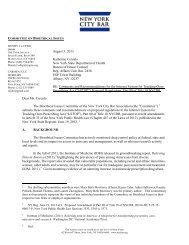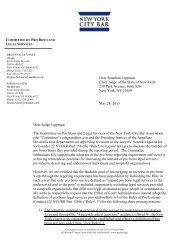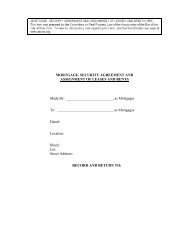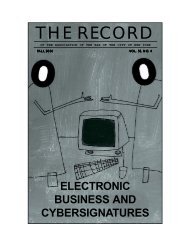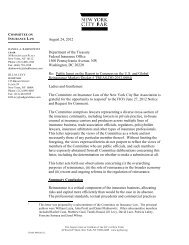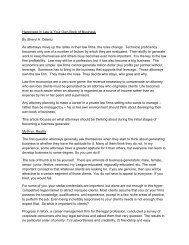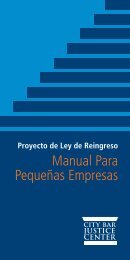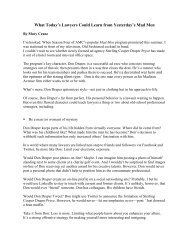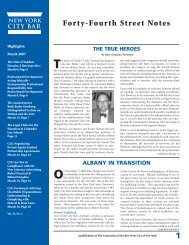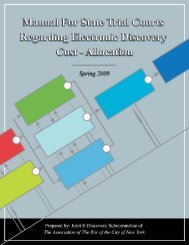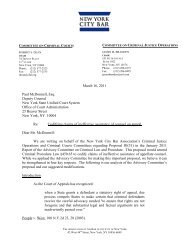2007 Issue 1 - New York City Bar Association
2007 Issue 1 - New York City Bar Association
2007 Issue 1 - New York City Bar Association
You also want an ePaper? Increase the reach of your titles
YUMPU automatically turns print PDFs into web optimized ePapers that Google loves.
C I V I L R I G H T S, I N F O R M A T I O N T E C H N O L O G Y L A W,<br />
L E G A L I S S U E S A F F E C T I N G P E O P L E W I T H D I S A B I L I T I E S<br />
B. A Website Is One of the “Goods, Services, Facilities,<br />
Privileges, Advantages, or Accommodations of”<br />
a Public Accommodation”<br />
Limiting “place” to a location large enough to accommodate human<br />
bodies ignores the rest of the section in which Congress uses the term<br />
“place.” First, discrimination is prohibited in the full and equal enjoyment<br />
of “the goods, services, . . . privileges, advantages, or accommodations,”<br />
as well as of the “facilities” of public accommodations. 26 Second,<br />
discrimination is prohibited “by” the covered entity—not the “place”—<br />
in the enjoyment “of”—not “at” or “in”—the place of public accommodation.<br />
27 Both terms necessarily extend the prohibition of discrimination<br />
to more than physical space. “At,” if used, might limit “full and equal<br />
enjoyment” to events “at” the physical place. 28 Instead, Congress chose<br />
“of.” Even if “of” were ambiguous and could mean “at,” interpretation<br />
of the ADA requires that any ambiguity be interpreted to confer more—<br />
rather than fewer—rights on the protected class of people. 29 The interpretation<br />
is reinforced by the subheading of the statutory section itself, “Prohibition<br />
of discrimination by [not at] public accommodations.” 30<br />
A further illustration of the applicability of Title III both to nonphysical<br />
elements associated with a physical entity and to pure-cyberspace<br />
entities is found in other prohibitions of Title III that clearly are not<br />
limited to physical matters. Thus, in Title III, “failure to remove architectural<br />
barriers, and communication barriers that are structural” 31 is only<br />
one example of prohibited discrimination, listed only after many other<br />
prohibitions. 32 These other prohibitions, not tied to physical places, but<br />
26. 42 U.S.C. § 12182(a).<br />
27. Id.<br />
28. See Hooks brief at 8 (“The Services “Of” A Place Of Public Accommodation Need Not Be<br />
Provided “At” The Place Of Public Accommodation”).<br />
29. See Arnold v. United Parcel Service, Inc., 136 F.3d 854, 861 (1 st Cir. 1998) (ADA is a<br />
“broad remedial statute” that should be “construed broadly to effectuate its purposes”) (internal<br />
citations omitted).<br />
30. 42 U.S.C. § 12182 (emphasis added). The expansive reading of “of” also is reinforced by<br />
the language of Title II of the ADA, which prohibits discrimination on the basis of disability<br />
in the “services, programs, or activities of a public entity.” 42 U.S.C. § 12132. This provision,<br />
along with its implementing regulations, has been found to require Website accessibility for<br />
public transit information. Martin, 225 F. Supp. 2d at 1377.<br />
31. 42 U.S.C. § 12182(b)(2)(A)(iv).<br />
32. These include: “Denial of participation . . . directly, or through commercial, licensing, or<br />
other arrangements,” id. § 12182(b)(1)(A)(i); “Participation in unequal benefits,” id. §<br />
T H E R E C O R D<br />
126



